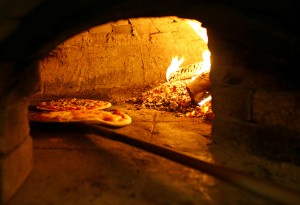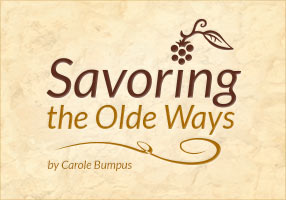We thought of ourselves as worldly. And I suppose for Swedish Methodists plunked down on the Nebraska plains we were, because early on we had been introduced to the world of international cuisine on our very doorstep.
It was through Old Gilberto. He would drive through our neighborhoods with a clunk, a clank, a rattle and a roar as his truck lurched along our partially paved streets. And his morning cry would resound above the clatter of his truck with his rich Italian dialect (that’s Eye-talian, for the uninitiated). He would offer to sell to all the housewives in our small town the delicacies of ‘slightly bruised’ cans of corn, peas, beans, succotash and, of course, our favorite which came in a ‘most superior’ yellow and brown tin by Franco-American. “Spaghetti and mothballs,” he would cry out. “Spaghetti and mothballs. Come get-ta you family fa-vo-rite! Six balls in every can.” We would giggle with glee.
On rare occasions—like when our Mom was in the hospital giving birth to one of my many younger brothers—my father would treat my older sister and me to a sit-down dinner in our local Greek restaurant. One time I actually ordered a real plate of spaghetti, and someone near me taught me how to ‘twirl’ my spaghetti strands with my fork onto my spoon. I remember then that my mind soared with dreams of international travel.
As a young teen, Sunday night for our family was pizza night. My sister would break out a box of Chef Boyardee’s pizza mix and create an extravaganza that only we could appreciate, for in that small mid-western town there were no pizza places and, therefore, no pizza delivery. She adeptly beat at the dough, let it rise, spread it on a cookie sheet, sprinkled a pound of raw hamburger across the top, and covered it with the package of dry yellow powder mix we assumed was cheddar cheese. She then popped it into the oven, and we called her ‘our gourmet.’ Funny thing is, a few years later when she got married, that was all she knew how to prepare.
Stepping forward in time—oh, maybe forty years or so—I found myself realizing my dream while on a traditional foods tour in the City of Salerno, in Compania, Italy along the Amalfi Coast. The goal of the tour, provided by ‘Oldways Preservation Trust,’ was to introduce food writers, cookbook authors, chefs, restaurant owners, early Slow Food Members, nutritionists and the rest of our ilk from around the world the traditional, regional foods of the region of Compania.
At this point in our tour, our guide and translator, a lovely American gal married to a Neapolitan, was on-stage in the hotel lounge busily teaching our group of one hundred or so—along with some dubious-looking, black, leather-jacketed interlopers—the original recipe for pizza.
“Just up the road is the City of Naples,” she said, “and it is considered to be the home of the first pizzas ever made. Since the 1830s, Neapolitans could tell you, there are only two true pizzas—the ‘Marinara’ which is the oldest and is made with a topping of tomato, oregano, garlic, basil and extra-virgin olive oil. (No seafood, in spite of the name.) And, ‘Pizza Margherita.’ This pizza was named after the Queen of Savoy in 1889 after she sampled this simple but elegant pizza made with fresh (green) basil, (white) mozzarella cheese and ripe (red) tomatoes—the same colors of the Italian flag. Only a true Neapolitan pizza,” her chin rose with the telling, “can be made with ingredients that come from this area—San Marzano tomatoes grown on the slopes of Mt. Vesuvius, fresh basil grown locally and olive oils which come from the vineyards that reach into Naples herself.”
While she was busy talking, a portly blonde, blue-eyed, red-faced man pulled on a chef’s jacket and popped on his toque, before walking onto the stage. In the background and close to the back doors, we could see large dome-shaped, portable wood-fired pizza ovens. Bundles of faggots were bringing the ovens up to the required heat. 485 degrees C. Cooking assistants appeared and began setting up the demo table with glossy rounds of pre-made dough, along with bowls of chopped garlic, fresh basil, oregano, thinly sliced tomatoes—San Marzano, I presume—slices of fresh regional buffalo mozzarella cheese, along with a plethora of tall, green bottles of local olive oils which stood like soldiers, as if at attention.
Then the chef began his demonstration of the culinary process. Our guide busily translated his every word. Step by step he moved, like a well-choreographed dancer. He pummeled, rolled, then shaped the dough with his fingers and hands only. No machines or rolling pins allowed. No-no-no! He slapped the pizza dough down on the counter, and then spread it thin. He reached for the sliced tomatoes and with a flick of his wrist fanned them clockwise like a deck of cards onto the surface. With a splash of olive oil and a sprinkle of herbs, he then laid out the buffalo mozzarella cheese, before following with a delicate touch of fresh basil. Just off-stage the savory aroma of fresh tomatoes, cheese and herbs was beginning to waft in our direction along with the acrid odor of slightly burned crust. Our appetites were whetted. We were ravenous.
The crowd oohed and aahed reverentially in all the appropriate places as we slurped down a—yes, a local regional wine. An enthusiastic few leaned forward to catch each and every nuance of the aforementioned techniques, writing notes in a furtive frenzy. Somewhere in the midst of vast trays lined with steaming hot wedges of pizza being circulated through the horde, I became aware of a slight lull in our translator’s voice. She came to an abrupt stop. She turned to the chef beside her, her eyes wide open with alarm. A murmuring began to stir the crowd; voices began to lift; then shouts in thick Neapolitan split the air. The burly, black leather jacketed interlopers suddenly were moving toward the stage. A chair was lifted high as if to be brandished.
“What is happening?” we whispered to each other. “What is going on?”
The bartender, safely ensconced behind the bar, leaned over to us and in a gruff repartee, began to explain. “It’s like this. The chef—it appears he’s from the North,” he gestured to the ceiling. “He has the audacity to come down here to the South and explain our birth right? Pizza?” He sneered again. I guessed that wasn’t a question he was posing.
Quickly the on-stage chef exited along with his Northern-Italian counterparts. Pizza ovens were slammed shut with pizzas still baking over hot coals, as the crew squealed out of the parking lot. The room emptied; the voices dropped and I licked the essence of the one small sliver of pizza I had sampled from my finger tips.
“Well, I’ve always wanted to go somewhere dramatic,” I said, grinning at my compatriots. “But until now, I had no idea who put the ‘drama’ into Italian food. All this time I thought it was Gilberto!”
“Another round?” asked the bartender.


Leave a Reply